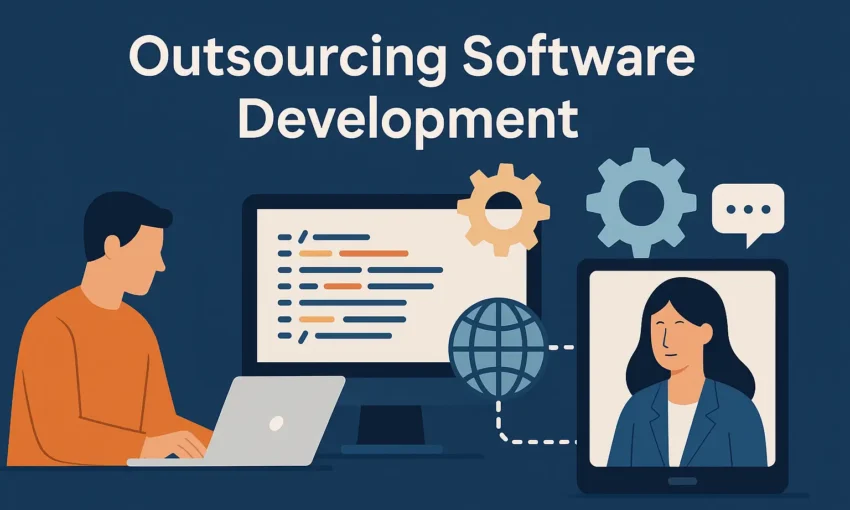Outsourcing Software Development: A Step-by-Step Guide to Success

Why Outsourcing Software Development Makes Business Sense
In today’s competitive digital world, outsourcing software development is a smart move for businesses wanting to grow quickly without breaking the bank. Whether you’re a startup with limited capital or a well-established company in need of specialized skills, outsourcing allows you to reduce costs, speed up delivery, and access global talent.
According to Deloitte, over 70% of companies outsource to cut costs, while many others do it to gain access to expertise not available in-house. These benefits make it a no-brainer for companies looking to scale efficiently and compete globally.
Step 1 – Nail Down Your Project Requirements and Goals
The key to successful outsourcing starts with a clear project definition. Before reaching out to developers, take some time to write down your requirements, goals, and expectations. In short, define project goals before outsourcing.
Start by creating a detailed project specification that outlines your business objectives, target audience, required features, and technology stack. Clearly separate must-have features from nice-to-haves. Also, set your time limits, budget, and quality expectations.
Consider your internal capacity for project management and communication. This helps determine what support you’ll need from your outsourcing partner.
Step 2 – Evaluate Potential Outsourcing Partners
Choosing outsourcing development companies requires more than just comparing price tags. Look for firms that are experienced with your technology stack and industry. Assess their portfolios, communication practices, and cultural fit.
Check their case studies, read reviews, and request references. Make sure they understand your project’s tools and frameworks. Also, confirm that they follow agile practices, have solid quality assurance processes, and can scale when necessary.
Don’t forget to verify their data security policies and intellectual property protections.
Step 3 – Set Up Clear Communication and Project Management
Good communication is the backbone of any remote development team management strategy. Establish protocols from the start—decide on meeting schedules, communication tools, and progress reporting methods.
Use tools like Jira, Asana, or Trello to coordinate tasks. Define roles and responsibilities clearly. Maintain well-organized documentation and shared resources. Consider assigning a dedicated project manager to bridge any gaps between your internal team and the outsourcing partner.
Step 4 – Draft a Solid Contract and Service Agreement
Strong outsourcing software development contracts protect both sides. Work with legal professionals to draft agreements that cover deliverables, timelines, payment schedules, and IP ownership.
Include Service Level Agreements (SLAs) with detailed performance metrics, quality benchmarks, and response timelines. Clearly state acceptance criteria and change management processes.
Ensure the contract also addresses data protection, documentation handover, post-launch support, and termination clauses. Add dispute resolution protocols and specify governing law.
Step 5 – Implement Strong Quality Assurance and Testing
Never treat QA as an afterthought. Effective QA in software outsourcing begins early and continues throughout the development lifecycle.
Define quality standards for each milestone. Use a mix of code reviews, automated testing, and manual QA. Implement continuous integration and continuous deployment (CI/CD) pipelines.
Schedule regular demos for feedback and adjustments. Include user acceptance testing (UAT) and plan for performance, security, and compatibility checks.
Step 6 – Ensure Smooth Handover and Long-Term Support
A well-managed handover process in software outsourcing ensures your internal team can maintain and evolve the product post-launch.
Request full documentation, including user guides, deployment manuals, and source code. Confirm that all code is properly commented and follows best practices.
Organize knowledge transfer sessions. Discuss ongoing support, bug fixes, and future updates. Also, plan for training and internal adoption to ensure smooth rollout.
Conclusion
Outsourcing software development doesn’t have to be complicated. By following these six steps, you can reduce risks, ensure high-quality results, and build strong, long-lasting partnerships.
Remember, outsourcing isn’t just about cutting costs. It’s about gaining access to expertise, accelerating time-to-market, and letting your internal team focus on what they do best. With the right partner and strategy, outsourcing can be a powerful catalyst for your business growth.
FAQs
1. How do I know if outsourcing software development is right for my business?
Outsourcing works great when you don’t have the necessary skills in-house need to scale quickly want to cut costs or need specific skills for a project. Plus if your internal team is overloaded and you’re looking for faster results outsourcing could be a good option.
2. What kind of cost savings can I expect from outsourcing software development?
Cost savings can vary based on where you outsource and how complex your project is but many companies save around 30-60% compared to hiring full-time developers. Just make sure you focus on value not just low cost since quality and speed often offer better returns than simply choosing the cheapest route.
3. How can I protect my intellectual property while outsourcing development?
Make sure to protect your IP with solid contracts that include non-disclosure agreements (NDAs) clear ownership rules and confidentiality clauses. Go for trustworthy partners that have strong data security measures do your homework on their legal compliance and consider working with companies in places with good IP protection laws.
4. What are some common issues in software development outsourcing and how can I steer clear of them?
Common problems include communication gaps time zone differences quality worries and scope changes. To avoid these set up clear communication protocols pick partners with similar working hours have strong quality checks in place and keep detailed documents with well-defined requirements.
5. How long should a typical software development outsourcing project take?
Project timelines can differ a lot based on complexity and requirements. Simple apps might take about 2-4 months while complex solutions could take 6-18 months or more. Things that can impact the timeline include team size tech complexity integration needs and the thoroughness of your initial planning and requirements gathering.





